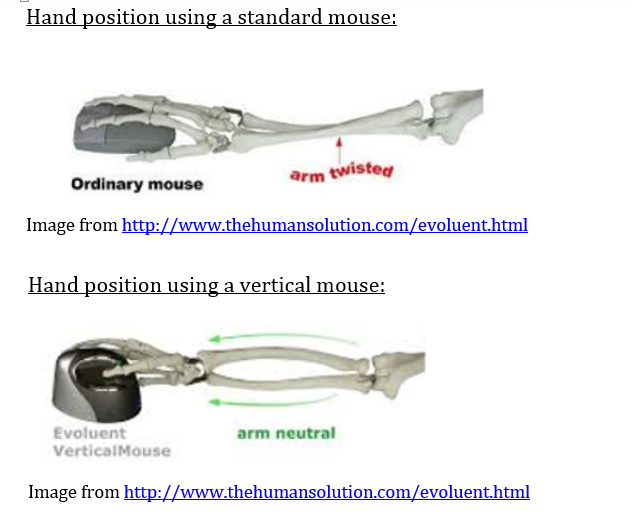In nearly all occupations computer time makes up a significant portion of the work day. This is especially true for knowledge workers, who generally complete their work in an office environment. With the large proportion of work time dedicated to computer use, much of this relates to interaction with the mouse to perform various actions.
Traditionally, mice are designed in a standard “horizontal” manner, where the user must turn their palm to face downward to interact with the device. This movement and sustained posture requires the forearm to rotate away from its natural position. With the forearm and palm in this position, research shows an increased pressure on the carpal tunnel and median nerve, decreased blood flow and localized muscle fatigue; this ultimately leads to an increased risk of various upper extremity musculoskeletal disorders (MSD)(Keir, Bach, & Rempel, 1999). In fact, during our practice, we often consult with individuals who are experiencing various upper limb MSD issues (carpal tunnel syndrome, epicondylitis, tennis elbow, etc) and their symptoms are aggravated by using the traditional mouse design.
Fortunately, other mouse designs do exist, and these designs hold potential to reduce the reported MSD issues. One such design is the “vertical” mouse. A vertical mouse positions the forearm in a neutral position (a handshake position), which results in less twisting of the forearm and less tension on the forearm muscles. Ultimately, this can decrease muscle activity, reducing strain and fatigue. In addition, this posture does not place pressure on the carpal tunnel or along the wrist and hand, further reducing risk factors and potential to aggravate symptoms.

A study completed by Quemelo & Vieira, 2013 measured muscle activity when using a standard and vertical mouse (Quemelo & Vieira, 2013). Their results show that there was less wrist extensor muscle activity when using the vertical mouse. Extensor muscle overuse may result in tendonitis of the elbow (aka. Tennis elbow), which is a very common upper extremity disorder found with repetitive mousing.
Although the vertical mouse has several benefits, productivity and performance can be decreased. This may be a result of the user relying on larger muscle groups to move the mouse, thereby reducing some finer movement details. However, practice and training can increase accuracy and performance.
There are many vertical or slanted mice that would be recommended to maintain neutral position while mousing. The selection of the right device for you will depend on your hand size, symptoms, and nature of work tasks. Discussion with an ergonomist can help to find the best option for your work.
Here are just a few examples of vertical mice:

References:
Keir, P. J., Bach, J. M., & Rempel, D. (1999). Effects of computer mouse design and task on carpal tunnel pressure. Ergonomics, 42(10), 1350-1360.
Quemelo, P. R. V., & Vieira, E. R. (2013). Biomechanics and performance when using a standard and a vertical computer mouse. Ergonomics, 56(8), 1336-1344. doi: 10.1080/00140139.2013.805251

